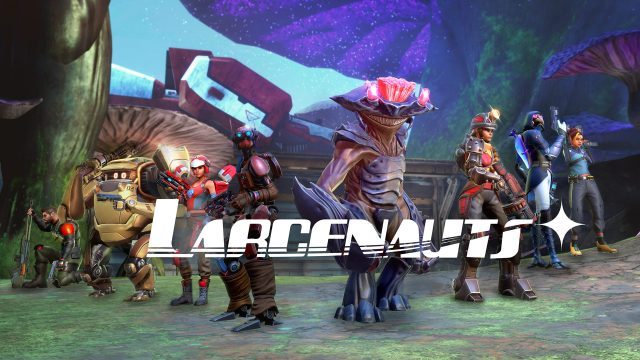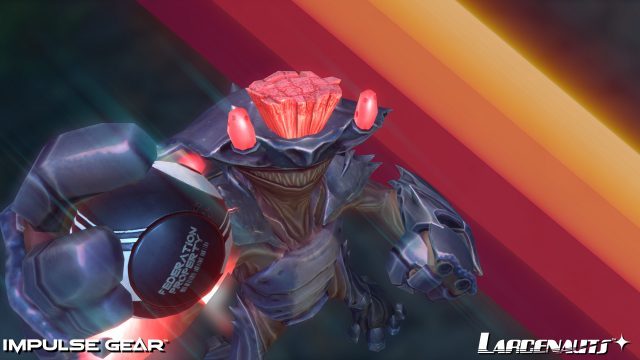Four years after its acclaimed title Farpoint, developer Impulse Gear is back with a new VR game, Larcenauts. This time around it’s something very different: a multiplayer-only hero shooter with strong Overwatch vibes.
Larcenauts Details:
Available On: Oculus Quest & Rift (cross-buy), Steam
Cross-play: Yes
Price: $30
Developer: Impulse Gear
Release Date: June 17th, 2021
Reviewed On: Quest 2
Gameplay
If there’s one thing that’s clear about Larcenauts, it’s that the game is technically very sound and feels like a complete package. Even on Quest 2 the game is sharp, runs smoothly, and has strong and consistent art direction. Granted, the graphics ultimately look entirely designed around Quest’s limitations.
Despite only having four maps at launch, the game’s eight unique characters (each with two loadouts and two ‘Power Slate’ slots for specialization) make it feel like there’s a lot on offer here in terms of different ways to play the game and things to unlock.
Matches are 6v6 and played across three gametypes which roughly fit themes of territories, capture the flag, and deathmatch. Matches are generally short and sweet, not likely to last longer than 15 minutes. And when a match ends there’s little downtime before a new one begins automatically.
The gameplay is very much on the run-and-gun end of the spectrum with some opportunity to be tactical. That’s to be expected, as Larcenauts is designed to be a fast-paced game, with all characters being able to sprint and some having extra mobility options like dashing and sliding. Players can also vault over short walls and grapple at designated points to leap up significant heights. Thankfully the game manages to feel very comfortable, even with all the movement (more on that in the Comfort section below).
Each character has two weapons, a tactical ability, a deployable item, and a unique grenade. In the first few rounds you’re likely to feel like you’re getting destroyed by other players until you start to get a feel for how to best use your character’s weapons and abilities (not to mention learning what other characters are capable of). Characters can have vastly different damage output, so if you aren’t playing smart it’s easy to get yourself into a bad position and get melted by, say, the big robot character Thal who can raise a one-way shield and destroy you easily in a 1v1.
Each gun in the game also has the ability to ‘overcharge’, which you do by gripping the gun with your off-hand and holding the off-hand trigger. For instance, the SMG overcharge causes it to shoot incendiary rounds, while overcharging the shotgun tightens the choke for more damage at a greater range. Overcharging a gun uses a limited resource which is collected over the course of the match by killing enemies (though this risks creating a feedback loop that leads to a power imbalance between teams).
Between all the characters, loadout variations, abilities, grenades, and weapon overcharging, it feels like there’s a good amount of depth on paper, but I haven’t felt the gameplay really synergize into something that feels deeper than quick skirmishes scattered across maps which feel better suited to a free-for-all arena shooter than a team-based hero shooter.
There’s some fun to be had, but also some balance issues to work out. The starting character, for instance, has a loadout which allows her to dual wield SMGs. Combined with her ability to drop an AOE buff that increases the rate of fire, the dual SMG loadout can drop you before you have a chance to react. Not to mention that if she gets into a pinch she can easily dash away from the fight thanks to her movement ability. Below is two clips of me getting completely melted by the dual SMG loadout before I had any idea what was happening:
In many cases character abilities feel like they have too much influence on the outcome of individual fights. For instance, Evander, the ranged hero, has an ability which makes him instantly invisible, which can feel unfair to fight against:
Immersion
While Larcenauts scores high in technical competency and appears to have depth to its mechanics, it doesn’t offer much in the way of immersion. The gameplay is largely based on sticks for movement and buttons for abilities. The most immersive elements of Larcenauts are aiming your guns and throwing grenades with your hands, and even then these aren’t particularly immersive. There isn’t a strong sense that the game is really leaning into VR’s unique capabilities.
Gun handling is heavily simplified. While holding a gun with two hands will stabilize your aim—in fact some guns would be useless if you didn’t—only your main hand contributes to actually moving the gun. Once you grab on with your off-hand, it has no influence over the position of the gun, which almost makes it feel like you’ve lost control of your arm.
Reloading is similarly simplified with a console-style ‘press button to reload’ which triggers a pre-animated reload sequence that just sort of… happens to you. It’s weird to see the gun doing its own thing with flashy flipping animations as it reloads while you’re not directing any of it. Not every VR game needs realistic reloading, chambering, and the like—after all, Larcenauts is supposed to be a fast-paced game and you probably don’t want to be fumbling with mags—but pressing a single button and watching a reload animation doesn’t feel quite right.
It surprised me that Impulse Gear took this approach considering their prior game, Farpoint, had a very smart reloading design that was simple while also being immersive. In that game once you depleted your ammo you’d press a button and the gun would essentially recharge over time. Mechanically it’s no different than how reloading works in Larcenauts, except that the guns didn’t go flipping out of your hands on their own accord.
The character Vod, the rock alien, is really the one exception in the immersion department. Since they have no guns and instead use their stretchy arms as weapons, you initiate punches by actually doing a punching gesture which is way more immersive in this case than it would be if you just pulled a trigger to send the arms flying.
Beyond that, don’t expect to do any physical dodging of projectiles, crouching behind cover, interesting gestures, or direct interactions with teammates in Larcenauts. At a minimum I was hoping that the game’s grappling mechanic would be done by reaching out to a grapple point, making a connection, and then doing a ‘pulling’ gesture to yank yourself up the incline (in fact, the game’s trailer showed as much), but unfortunately you just press forward on your thumbstick near the grapple point and it all happens automatically.
Curiously, these missing immersion elements don’t seem to have gone unnoticed by Impulse Gear. The studio has published a post-launch roadmap which indicates that updates a planned which will indeed bring two-handed aiming and manual reloading to the game at some later date. Why these things weren’t part of the game at launch is unclear.
There’s one thoughtful immersive touch that’s actually disabled by default, which is the ‘Immersive Sprint’ setting that activates sprint when you point your gun down. Because you can’t use your weapon while sprinting in Larcenauts anyway, this ends up feeling much more natural (and even easier to do) than clicking in the thumbstick to sprint.
Outside of matches, Larcenauts actually brings a bit of immersive-focused design in the game’s menu. Instead of simply having a menu screen in front of you, the ‘menu’ is a virtual space where you move between different terminals to access various elements of the menu (ie: progression, character loadout, challenges, etc). Ultimately all they’ve done is split the menu up into different screens and scattered them around a virtual space, but I find it easier to process and remember all the different menu functions thanks to their spatial organization.
If you join a party with friends, they all appear in the same shared space which is much more interesting than just seeing their names in a party list.
And another neat little immersive touch there in the menus: while the game uses a basic laser-pointer-on-screen design for interacting with the menus, it actually makes you pick up a pointer tool that’s sitting next to each of the menu screens to give a contextual reason for having a laser pointer, rather than it simply shooting out of your hands. It’s a trivial difference mechanically, but a smart little bit of design and one I would love to see elsewhere (if games continue to insist on laser pointer menus, that is).
Comfort
Larcenauts relies exclusively on smooth locomotion and doesn’t offer teleport. Granted, I found the game surprisingly comfortable, even with all of its stick strafing, dashing abilities, grappling, and occasional vaulting.
I was able to play easily for an hour or more with no hint of nausea, which isn’t always the case for games with aggressive smooth locomotion. In my time with the game so far I haven’t found any particular ability or action where I felt any obvious discomfort.
It looks like Impulse Gear took a lot of care to get comfort right, and we can see as much in the range of comfort and control options that are made available to players:
Larcenatus Comfort Options
Turning |
|
| Artificial turning | ✔ |
| Smooth-turn | ✔ |
| Adjustable speed | ✔ |
| Snap-turn | ✔ |
| Adjustable increments | ✔ |
Movement |
|
| Artificial movement | ✔ |
| Smooth-move | ✔ |
| Adjustable speed | ✔ |
| Teleport-move | ✖ |
| Blinders | ✔ |
| Adjustable strength | ✔ |
| Head-based | ✔ |
| Controller-based | ✔ |
| Swappable movement hand | ✔ |
Posture |
|
| Standing mode | ✔ |
| Seated mode | not explicit |
| Artificial crouch | ✔ |
| Real crouch | ✔ |
Accessibility |
|
| Subtitles | ✔ |
| Languages | English, French, German, Spanish, Japanese, Korean |
| Alternate audio | ✔ |
| Languages | English, French, German, Spanish, Japanese, Korean |
| Adjustable difficulty | ✖ |
| Two hands required | ✔ |
| Real crouch required | ✖ |
| Hearing required | ✖ |
| Adjustable player height | ✔ |
Overall Score: 7 – Good WE SCORE ON A LINEAR SCALE – Learn More
Larcenauts is a technically well made game with strong art direction, great performance, and a sense of progression with eight characters to unlock, each with different loadouts and customizations. In its launch state the gameplay feels more like a run-and-gun free-for-all than a team-based hero shooter, and it may take a balance pass (or two) to get things closer to the latter. While Larcenauts has the breadth of mechanics that you’d hope to see in a hero shooter, it’s missing a ‘made-for-VR’ hook due to minimal VR-specific interactions. The developer has promised that more immersive interactions will be added down the line, but it’s a shame they aren’t part of the game from the get-to.
Gameplay: 7 | Immersion: 6 | Comfort: 8






